

Amazonian Carnival is a rich, highly interactive, multi-user, 3D virtual environment that evokes the mystery of the Amazon and the steamy sensuality of a Brazilian Carnival. It is part street dance, adventure film, misty fantasy, concert, vivid history, touristic vacation, and part ecology lesson. It is all of these and more.
"Amazonian Carnival" will be to virtual reality what "Gone with the Wind" was to color film. Amazonian Carnival is a 3D, multi-user virtual reality environment that creates a rich, highly interactive mythic representations of the northern Brazilian town of Belem and mythic construction of a section of the Amazonian rainforest.
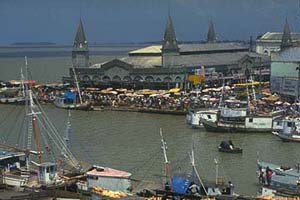
It is called Amazonian Carnival because the beautiful, historic town of Belem sits at the mouth of the Amazon. An international team will design a virtual, interactive model of Belem. The team will also create a mythic virtual model of Amazonian ecology.

This rich, multi-environment design will allow researchers, artists, and computer designers to explore:
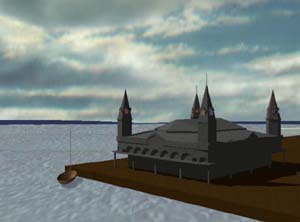
The Amazonian Carnival if the first experience of its kind. It is also an experiment in collaborative international university training and research. The environment will be designed by multinational teams of faculty and students as part of the process of university education in virtual environment design, VRML and WWW training and human-computer interaction.
The building of the interactive experience of Amazonian Carnival will serve a testbed for:
The Amazonian environment will be designed for multiple means of distribution:
The first two means of distribution are intermediate means until the arrival of high-bandwidth distribution via Internet 2 or equivalent system, and later generation of VRML in 1998 and 1999.
Basic Interface:
Users enter the virtual environment either via:
1) standard VRML2 browsers,
2) stereoscopic VRML browers, or
3) immersive virtual reality using head-mounted displays.
In the early phase these experiences will only be availabe in participating university laboratories. In later phases they will be available to anyone in the world with a WWW connection.
Users enter the world and find themselves on the deck of a classic, Portuguese passenger boat. The wind is blowing and the ocean surrounds them. Gulls fly overhead and crew is busy preparing to dock at the port of Belem, Brazil. A calendar indicates it is February, 1913, but the environment feels like a post-modern mix of the past and the present. The discover that their luxury liner has left Lisbon for the town of Belem, Brazil.

On the deck they meet strange passengers and members of the ship's Portuguese crew who tell them wild stories about the Amazon. Some sing praises of steamy dance, drink, romance, and sun. Some warn of dark, mysterious rituals. Others tell tales of great riches deep in the Amazon. A mad, crew member with one eye known as "the indian" insists that the Amazon and its ecology must be saved from the rubber barons and the "future." The future hangs over this world like a sinister myst.
The cruise ship docks next to the main street, Avenida Castillhos Franca, along the port and beach of a Brazilian coastal town of Belem, modelled loosely on the real Brazilian town of Belem. A frenzied festival similar to carnival is in progress. Street music groups lead the town's people in dance and marching through the streets. The music has flavors of Samba. Users are given drums and rattles by a street vendor. They are invited to join in the parade by a dark, beautiful woman dressed in red and yellow plumage, like a sensuous Amazonian bird.

As the users dance along the streets of the Carnival, they meet strange costumed characters who either want to enlist them to save the soul of Amazonia and others who insist that they just enjoy the sensual pleasures of Carnival.
The tug between the sacred and the profane is woven into the fabric of the town. But the sacred is not what it seems, and the profane sometimes takes on sacred tones. In the rich interactive environment they can participate in the festival, dance in the streets, and play their percussive instruments in step with the Samba beat. On the streets with them they meet other people from all over the world who have come to loose themselves in rituals of virtual Amazonia.
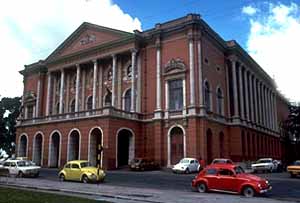
They can also walk or take a streetcar to the side streets or loose themselves in the "Ver-o-Peso" (VRML prototype - need Live 3D plug-in) market. There, they discover all kinds of groups of characters and environments as they meet the locals of the coastal town: "filhos do mato", children at play, rubber plantation owners, smiling prostitutes, happy drunks, Jesuits, cunning thieves, mad sorcerers, dogs, the vain mayor of the town, the queen of the carnival, local samba bands, lost Amazonian tribesmen, etc.
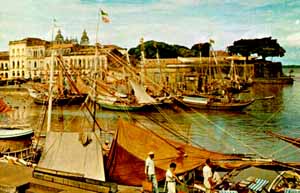
In the market they find bizarre products from the virtual Amazon including "drogas do sertao" Users can also wander into the buildings where they can visit curious shops, the homes of the filthy rich and the destitute poor, the Teatro da Paz, the Palacio Antonio Lemos, the Basilica de NS de Nazare, a house of prostitution, curio and coffee shops, etc. They can also check into the international Transamazonica hotel where a special "room" will be given to them to store "goods" or to meet privately with people they encounter in the virtual environment.
If users board a small boat off the pier, the find themselves transported up a river into the steamy, green jungles of the virtual Amazon. Jungle and animal sounds are all around them. Plants and animals derived from genetic algorithms thrive, evolve, and die in the virtual jungle. Some will mimic the 15,000 animal species, and the thousands of fish and insect species. Some species will be peculiar to the virtual environment.
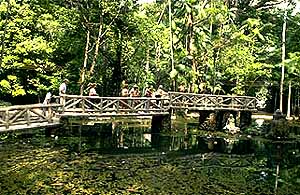
But, like the Amazon jungle, the virtual Amazon will evolve. It will never be exactly the same each time it is visited. On the river they meet traders who tell them secrets about Amazonia. They drift by Amazonian tribes, see and participate in exotic rituals, explore ruins of past Amazonian cultures, and share the river with boats owned by international corporations seeking to use the resources of Amazonia.
If they can travel deep inside the jungle, they might have the once life time chance to meet an Amazonian legend, who is only know as "the old one." Some may seek to find the god-like figure of "the old one," but few will ever meet him. When the few do meet the "old one," it will be an avatar controlled by a real native of the Amazon. The real will cross over into the virtual, the sacred will clash with the profane.
Internet 2 Will Make This Project Possible
The World Wide Web is evolving to support rich, 3D interactive worlds. On November 1996, the American program to develop a new, high-bandwidth network called Internet 2 was announced. Internet 2 will link American universities to support advanced collaborative education, research, and social environments.
In February 1997 the Internet 2 program was endorsed and supported by the US President Clinton in his State of the Union Address. President Clinton set aside $100,000,000 for the ìnext generation Internetî initiative.
Internet 2, like Internet 1, is destined to be international. Shortly after its development Internet 2 will link to other high-bandwidth initiatives in Latin America, Europe, and Asia. Internet 2 will allow for high bandwidth connections. The goal of Internet 2 are connections as high as 1 gigabit per second. Internet 2 is designed to support the networking of highly immersive, 3D virtual environments.
VRML2 and the Living Worlds Initiative: Allowing 10,000 Prople from all over the World to Visit our Brazilian Carnival Site.
The whole environment will be built for VRML2.0 specification. This means that whole site will be built 3D computer graphics. The site will be managed using new software such as Sony's Community Place package. Such software.
The environments will be built using 3D authoring packages such as Alias Wavefront, 3D Studio, Truespace, and Cosmo Worlds. A version of the experience will also run in immersive virtual environment using Sense 8 virtual reality software.
Funding Partners
Funding partners are government agencies and foundations who are providing funds to support the project, university research teams, or collaborative educational exchange. The relationships with these organizations is established through appropriate funding channels.
All funding partners will be acknowledged on the WWW site, in all international reseach publications, and presentations at conferences.
Sponsors
Sponsors are private companies that will support the project with grants of funding, equipment, or services. All sponsors will be acknowledged on the WWW site, in all international reseach publications, and presentations at conferences.
Some sponsors will also be able to advertise inside the virtual world, and will be given a "storefront" on one of the streets of virtual Belem. This storefront can be a separate "experience" featuring that company or may connect directly to the company's WWW site.
Design Partners
Design partners are university research labs, university departments, or private design studios that are actively involved in building some part of the 3D world of Amazonian Carnival. Design partners may be building the architecture of the town of Belem, agents or characers in the town, or participating the in design of the avatar interface.
Design partners will participate in research and design, and be part of all relevant research publications produced by the project.
Cultural Support Partners
Cultural support partnerships involve relationships with educational and cultural institutions specializing in the Amazon, Brazilian culture, dance, and music, Indian culture, or general historical background relevant to the virtual environment.
Design Partners:
Amazonian Carnival will be the product of the international design team with designers at university-based VR and WWW design labs in Europe and South America. The international design team will be coordinated by the M.I.N.D. Lab, a virtual reality research lab at Michigan State University.
Michigan State University Media, Interface & Network Design MIND Lab Dr. Frank Biocca, Russ Vanneman, Jim Miller, Kristi Nowak. Digital Media Arts @Technology (dMAT) Lab Dr. Pericles Gomes, Tory Sawyer.
University of North Carolina at Chapel Hill Dr. Monica Richter, Romance Languages
Fernando Pessoa University, Portugal Dr. F. Ribeiro Gouveia, Henrique Bui, L. Borges Gouveia.
Invited Partners:
University of Nottingham, Great Britain
University of Connecticut, USA
Cornell University, USA University of Belaras Islands, Spain.
Universidade Federal do Para - Fabiano Paes de Andrade - Dept. of Architecture
Universidade Federal do Parana - CCE - Sergio Scheer
Universidade de Sao Paulo - LSI - Mauro Cavaletti
Savannah College of Art and Design, Georgia, USA
Brazilian Contacts for this project
Ameritech Corporation Through the $1.5 million endownment for the Ameritech Chair and the associated M.I.N.D. Lab.
Michigan State University Seed funding for an Onyx Reality Engine, Immersadesk, and TDZ computer.
Fernando Pessoa University Seed funding to build a virtual reality design lab.
Grant Proposals
Joint European Community/United States Consortia for Cooperation in Higher Education and Vocational Education and Training Submitted on May 1997.
National Science Foundation US-Brazil Exchange To be submitted in August 1997
McCarthur Foundation Fall 1997

last update by Gomes on May 23, 1997